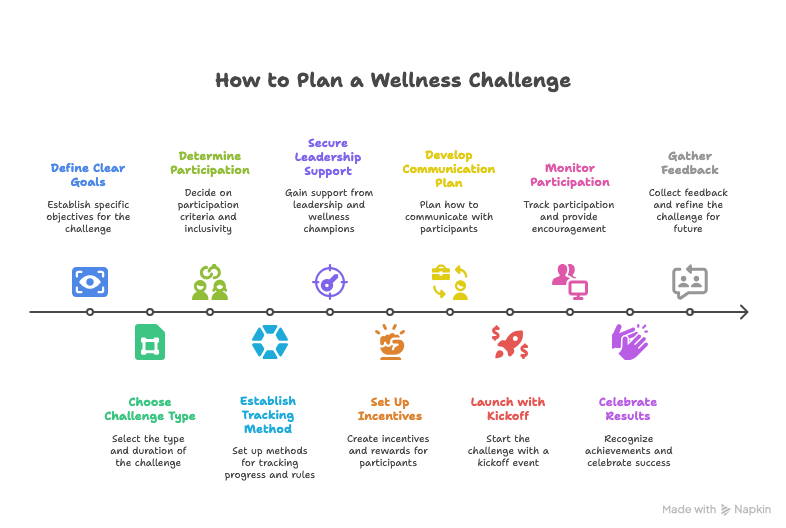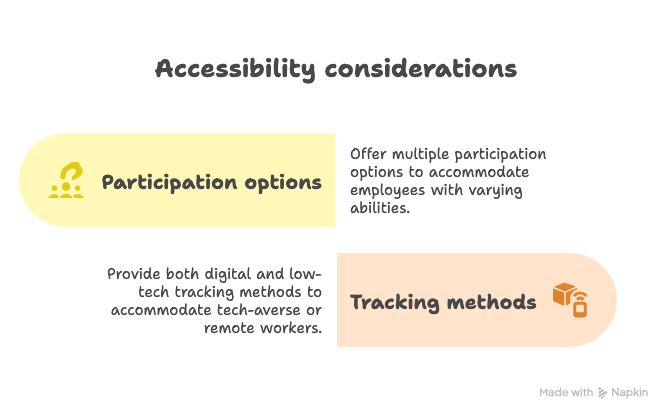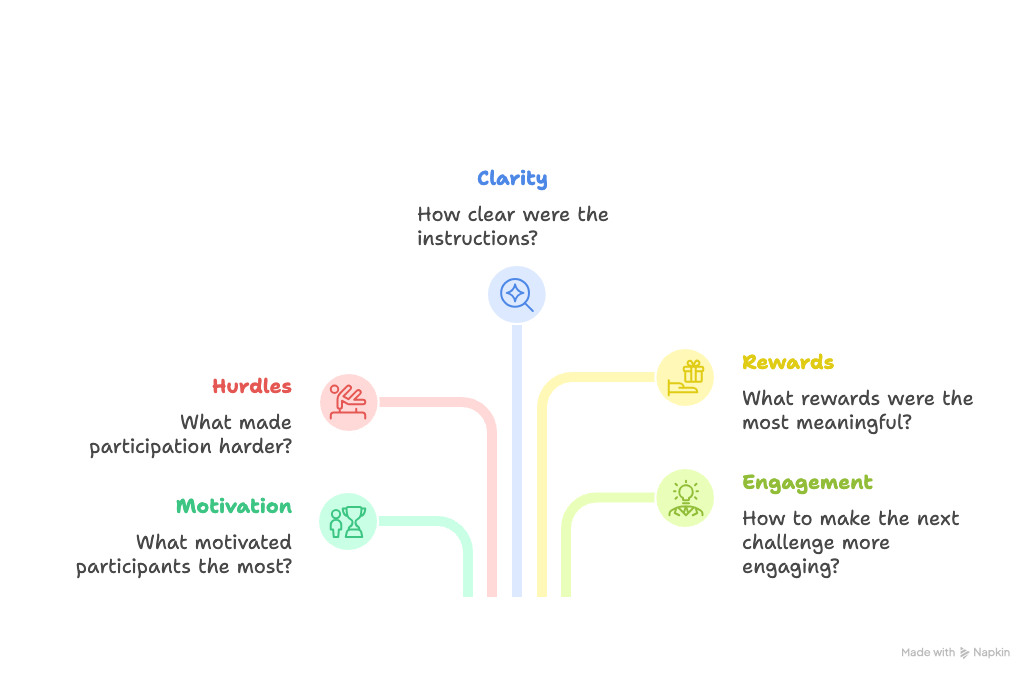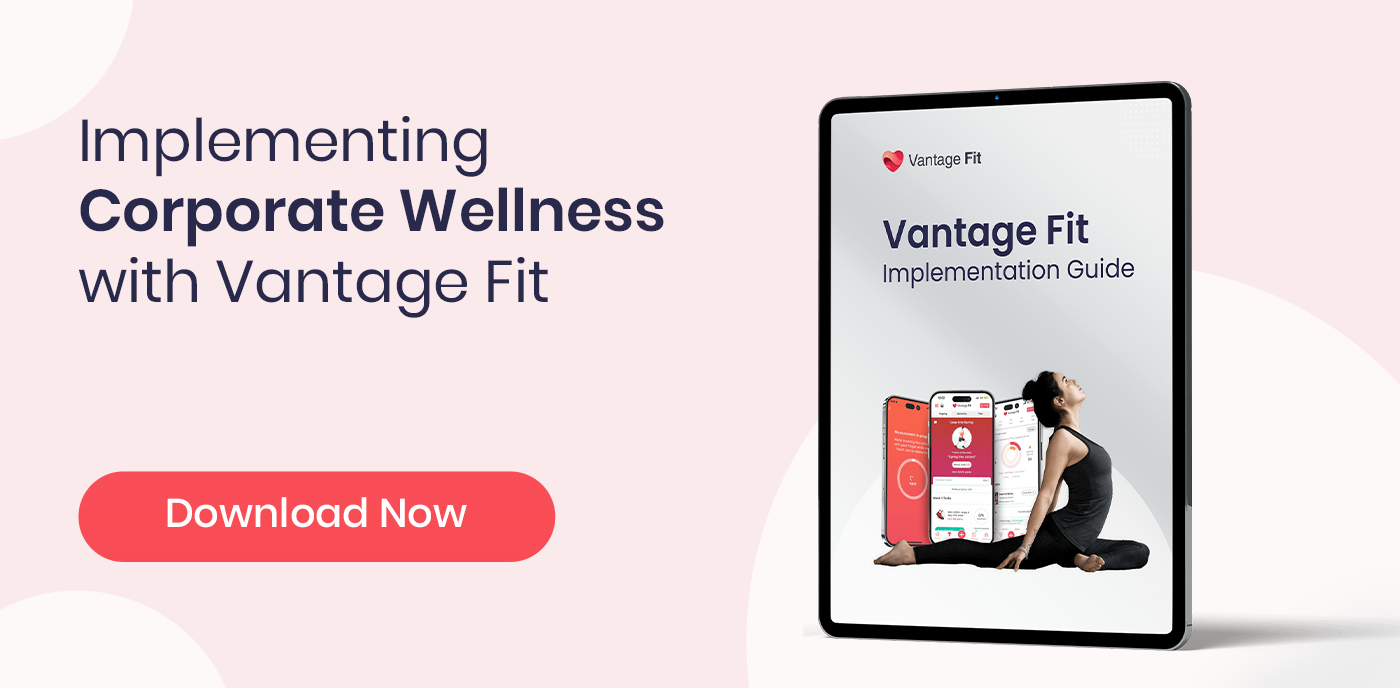How to Create an Effective Wellness Challenge for Your Employees
Wellness challenges are structured events that inspire employees to build healthier habits through friendly competition, progress tracking, and social support. Designed thoughtfully, these challenges typically last one to four weeks — short enough to maintain high engagement, yet long enough to spark meaningful change.
The key to success lies in combining simple, achievable actions with clear prompts and rewarding experiences that motivate participation.
A study, published in the National Library of Medicine, found that while education alone drives only about 5% of behaviour change, interventions focused on social support and environmental tweaks account for roughly 40% of lasting improvements (e.g., peer networks, leadership modeling, healthy-snack stations)
Now, as a leader, you might wonder: How to initiate and sustain such wellness behaviors? Which format will resonate across all fitness levels? How can one ensure the rules are fair, so everyone remains motivated? And what’s the secret to sustaining energy and participation beyond week one?
Don't worry, we’ve got you covered!
In this guide, we’ll explore proven strategies for designing employee wellness challenge ideas that truly engage your workforce, foster inclusivity, and drive sustainable employee health improvements —all while making the experience enjoyable and rewarding.
Before you dive into planning, grab our free 12-Month Wellness Calendar with ready-to-use challenge ideas for every month of the year.
Plan your Wellness Challenge

Planning your employee wellness challenge is where the magic starts!
It’s about understanding your team’s needs, setting simple goals everyone can get behind, and creating a structure that feels welcoming rather than overwhelming.
Let’s break this down step by step:
1. Define Clear Goals and Focus Areas
Every great challenge begins with a clear goal that guides the entire process.
- Start by picking one or two themes that genuinely matter to your team and fit with your organization’s wellness priorities. The themes could be from any of the nine dimensions of wellness.
- Next, set SMART targets- goals that are Specific, Measurable, Achievable, Relevant, and Time-bound.
Before you finalize your goals, calculate the potential return with our Wellness ROI Calculator to see how much your organization could save through improved employee health.
- Keep goals realistic by basing them on your team’s current habits and behaviors. If you make the challenge too ambitious, people might get overwhelmed; set achievable targets, and momentum will build naturally.
For example, “complete 30 minutes of physical activities daily over three weeks” looks achievable.
- Tie themes back to employee feedback or survey data. If your last wellness survey indicated that stress was a significant concern, a mindfulness challenge will likely feel more relevant than another step contest.
2. Choose the Challenge Type and Duration
Next, decide whether your challenge will be individual, team-based, or a hybrid. Below is a table to help you out:
| Format | Ideal for | Tracking Approach | Key Benefit |
|---|---|---|---|
| Individual | Remote or independent workers | Daily personal logs (steps, minutes, or entries) | Empowers self-paced progress |
| Team | On-site departments or project teams | Cumulative team totals updated on a leaderboard | Builds camaraderie and peer motivation |
| Hybrid | Mixed workforce with varied motivation levels | Individual entries roll up into team scores | Balances ownership with team spirit |
- When it comes to duration, aim for 1 to 4 weeks. Shorter challenges (7–14 days) lower the barrier to entry and ride the wave of initial excitement. Longer windows (3-4 weeks) give habits time to stick, but risk losing steam if communication falters.
- Use midpoint check-ins—such as a quick pulse survey or a progress snapshot—to maintain motivation and adjust the pace as needed.
Remember, flexibility is key. You can always run multiple small challenges throughout the year instead of a single lengthy one. The goal is to keep your team engaged, motivated, and eager to come back for the next round.

3. Determine Participation and Inclusivity
Too often, the same eager few dominate wellness challenges. Let’s change that by making everyone feel invited and valued.
- Create “Beginner,” “Intermediate,” and “Advanced” levels, each with gentle milestones. That way, someone easing in with daily stretch breaks can feel as celebrated as a seasoned runner.
- Use encouraging language. For instance, swap “compete” for “join,” “win” for “celebrate,”, etc. Words shape mindsets; try to keep them warm and inclusive.
- For remote and hybrid teams, host virtual meetups where people can share small wins, photos, or encouragement.
- Rotate challenge types across different dimensions (physical, mental, social) to tap into different interests and strengths.
Launch Your Wellness Challenge with us.
Set it up for Success
Planning sparks the vision, but execution determines whether your wellness challenge thrives or fades. Now, let's see how solid infrastructure—tracking tools, leadership buy-in, smart incentives, and consistent communication—turns your wellness challenge into a thriving reality:
4. Establish Tracking Method & Rules
Reliable tracking brings order and transparency to every challenge. To implement that,
- Choose platforms that your people actually use. It could be a fitness tracker, a wellness app, a shared Google Sheet, or simple paper logs for those who prefer tactile methods.
What matters is that the method feels natural, not forced.
- Establish rules that strike a balance between commitment and kindness.
Daily check-ins work well for step or water challenges, but movement minutes might allow a weekly summary for busy schedules.
- Make the rules simple enough to follow without strain: spell out what counts, when to log, and how to report missed days. Level the playing field by outlining how tie-breakers, catch-ups, or team scoring work—so everyone feels clear and confident from day one.
The best systems invite honest effort, not anxiety, and gently keep the group’s energy moving forward, together.
Keep privacy front and center by limiting personal data fields, anonymizing public leaderboards, and clearly explaining how data will be used and not used. Ensure all tracking tools meet accessibility standards (screen reader compatibility, mobile responsiveness) so that every employee can participate confidently and securely.
5. Secure Leadership Support & Wellness Champions

Leadership involvement is key.
When leaders participate and share their progress, it sends a strong message that wellness truly matters. Invite leaders to personally endorse the challenge and celebrate successes.
Build a small wellness committee with representatives from different departments, giving clear roles to keep momentum going. To prevent burnout, rotate responsibilities, regularly recognize efforts, and offer small tokens of appreciation.
This shared approach keeps champions motivated and the initiative sustainable.
6. Set Up Incentives and Rewards
Offering rewards/incentives can energize participation, but it’s all about striking the right balance. Below is a concise table to match your wellness budget with the most motivating mix of reward strategies:
| Budget Range | Reward Strategy | Examples |
|---|---|---|
| High ($50+) | Monetary incentives with public recognition | Gift cards, bonuses, HRA reimbursements |
| Medium ($20–50) | Experience-based perks with social recognition | Team lunch, extra PTO, newsletter highlight |
| Low ($0–20) | Recognition-focused rewards | Digital badges, thank-you notes, shoutouts |
Did you know? Research suggests that incentives above $50—such as a gift card or extra health-related reimbursement—tend to be most effective in motivating employees without overspending.
Ultimately, the key is to tailor your incentives so they feel meaningful rather than just transactional. If you do so, they’re far more likely to stay engaged and weave wellness into their everyday routine.
7. Develop a Communication Plan
A successful challenge speaks to every corner of your company through multiple channels. The table below maps out who hears what, when, and how, so your message lands clearly across channels and keeps the momentum alive from kickoff through celebration.
| Phase | Audience | Message | Channel |
|---|---|---|---|
| Pre-Launch | All employees | “Sign up with your team by Friday!” | Email, posters, chat groups |
| During | Participants | “Log 5,000 steps — leaderboard updated!” | Portal updates, Slack, email reminders |
| Post-Challenge | Organization-wide | “Congrats! Let’s celebrate our progress.” | Newsletter, recognition wall, HR mail |
Launch, Celebrate, and Improve
You have built the foundation and set up the systems. Now it's time to bring your wellness challenge to life, recognize the wins along the way, and capture insights that make the next round even better.
8. Launch with a Kickoff (CEO/HR note, event)
Visible leadership can make or break momentum. A study by the Global Wellness Institute found that challenges with CEO participation led to 45% higher sign-up rates and 30% more consistent engagement throughout the program.
To mirror that success, begin with a personalized launch email/flyer or short video from your CEO or HR lead. Use this template as a starting point:
Let’s Kick Off Our Wellness Challenge—Here’s How to Join!
Hello Everyone,
I’m happy to announce the start of our 30-day wellness challenge! Over the next month, small steps will add up to big wins in our health and happiness—together.
We’ve made getting started easy: click the link below or visit our [intranet page] to join. Throughout the challenge, we’ll share tips, stories, and encouragement that make staying active and mindful fun and doable.
I’ll be right there with you, taking part and cheering for every milestone. Can’t wait to see what we achieve as a team!
Feel free to reach out if you want more info or just want to say, “Count me in!”
Keep the kickoff brief and friendly. Start with a quick icebreaker and demonstrate how easy it is to log in progress. Share a motivating story to remind everyone that small steps matter. Prompt a simple first action, like logging today’s steps or sharing a photo, and reward that effort with a small prize or extra break time. This sets a positive, inclusive tone from the start.
9. Monitor Participation & Provide Encouragement
Tracking participation goes beyond just counting who signed up.
- Look at how often people log activities, engage in challenge chats, or celebrate teammates. These telltale signs reveal true involvement and help spot those who might be drifting.
- To re-engage quieter participants, reach out with friendly nudges—personalized emails or a quick message in a team chat highlighting their potential and offering support. Sometimes, a little encouragement or a reminder of small, achievable goals can spark renewed interest.
- Mid-challenge, refresh motivation with surprise micro-challenges, spot recognitions, or fun wellness quizzes.
Sharing stories of progress or small wins from varied participants also keeps momentum alive. Keep the tone light and positive, emphasizing progress over perfection to make everyone feel included and inspired to keep going.
9. Celebrate Results, Recognize Achievements
Recognition should lift everyone, not just the top scorers.
Below is a framework that offers straightforward ways to celebrate effort, progress, and support, helping build momentum and a stronger sense of community.
It’s about making sure everyone feels part of the success.
| Recognition Type | Criteria | Reward Format | Objective |
|---|---|---|---|
| Wellness Champion | Consistently active and supportive | Certificate + public shout-out | Motivate others through consistency |
| Most Improved | Greatest progress from baseline | Small gift or wellness prize | Encourage effort and growth |
| Team Spirit | Encouraging teammates, positive attitude | Team trophy + team lunch | Promote camaraderie and morale |
Seeing the framework, one can say that celebration becomes a shared victory that nurtures connection and lasting wellness habits.
10. Gather Feedback & Refine for Next Time
Collecting honest feedback is the key to making each employee wellness challenge better than the last. Use a mix of numbers and stories—quantitative data like participation rates and activity logs, paired with qualitative insights from open-ended survey responses or informal check-ins.
This mix paints a fuller picture of what worked and what didn’t.
After each challenge, reflect on the feedback and adjust your approach, messaging, incentives, or tech tools accordingly. This iterative mindset turns lessons into progress, building a program that fits your people and culture ever more closely.
Here are the important pointers to keep in mind after hosting the challenge:

Keeping feedback simple to give and easy to act on helps sustain a positive loop of growth and connection.
Having explained all the steps, executing them can still be daunting, which is why Vantage Fit simplifies the process so you can focus on engaging your team.
How Vantage Fit Simplifies Wellness Challenges?
Running a wellness challenge manually can be a juggling act and can quickly become overwhelming. Vantage Fit addresses this by providing an all-in-one platform where everything—from launching to tracking participation and rewarding employees—happens seamlessly in one place.
With automated activity tracking synced to wearable devices and real-time leaderboards, employees stay motivated through friendly competition, no matter where they work. The platform supports wide-ranging challenges—from simple step counts to personalized wellness programs including mental health, nutrition, and hydration—all tailored to fit your workforce.
L Sangita Devi, our Senior Account Executive, shares,
Most clients seek holistic solutions. They look for a platform that connects everything—from annual health checks and biomarker tracking to customized wellness journeys and partner collaborations. Companies appreciate how Vantage Fit provides this under one umbrella, whether it’s a simple step challenge or a full wellness ecosystem.
Adding to that, here’s what our client Rachel Arthur, Director of Benefits & Wellness at BISD, said about Vantage Fit:
Vantage Fit has helped our employees stay active, track their progress, and get rewarded—turning wellness into a daily habit that drives both health and happiness across BISD.
Ready to launch your next wellness challenge with ease? Schedule a Vantage Fit demo today and take the first step toward improving your team's health and engagement.
FAQs
What are the best wellness challenge apps?
Top employee wellness challenge apps include Vantage Fit for all-in-one wellness, BetterUp for coaching, and Strava for fitness challenges. They offer easy activity tracking, leaderboards, and social features to keep participants motivated and connected.
What are some wellness challenge activity ideas for different seasons?
Seasonal wellness challenges can be a great opportunity to tap into what each season naturally offers. For instance,
- Summer invites Outdoor walks, hydration goals
- Winter requires Indoor stretches and mindfulness breaks
- Autumn encourages Nature walks, gratitude journaling
- Spring motivates Outdoor Yoga, spring cleaning step challenges
How long should a wellness challenge last?
Aim for 4–6 weeks. This length helps build lasting habits while keeping motivation high and preventing burnout. Shorter bursts work too for quick boosts, but don’t stretch it so long that energy fades.




